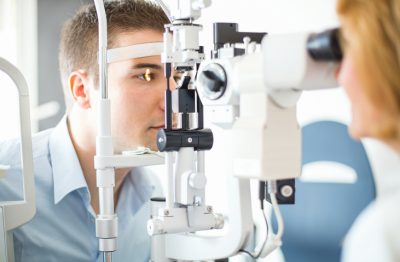Trusted Eye Doctors in Andalusia: Your Vision Wellness Specialists
Trusted Eye Doctors in Andalusia: Your Vision Wellness Specialists
Blog Article
Recognizing the Various Vision Adjustment Procedures Available for Clearer Sight
In the world of vision modification procedures, a plethora of choices exist to deal with refractive mistakes and supply individuals with more clear sight. From the extensively acknowledged LASIK surgical treatment to much less invasive treatments like PRK and implantable lenses, the field of ophthalmology offers a series of methods customized to fit various requirements and choices. Each procedure features its own collection of considerations, advantages, and potential threats. Comprehending the subtleties of these vision adjustment approaches is important for making educated decisions concerning one's visual wellness. Let's check out the intricacies of these procedures and lost light on the path to attaining improved vision clearness.
LASIK Surgery
LASIK surgery is a common refractive treatment made use of to deal with vision troubles such as farsightedness, nearsightedness, and astigmatism. This surgical technique, which stands for Laser-Assisted in Situ Keratomileusis, intends to improve the cornea to enhance how light is focused on the retina, inevitably boosting vision clearness.
One of the primary advantages of LASIK surgical procedure is the fast enhancement in vision experienced by clients. Many people observe a considerable enhancement in their sight quickly after the treatment. Additionally, most people report very little pain and pain during the surgery and recuperation period. The recuperation time for LASIK is fairly quick, with several individuals returning to their everyday activities within a day or 2 post-operation. In general, LASIK surgery is a prominent choice for people seeking a long-lasting service for their vision troubles.
PRK Procedure

PRK is an ideal alternative for individuals with slim corneas or those at a greater risk of eye injuries, as it does not entail producing a corneal flap. The recovery process for PRK is somewhat longer contrasted to LASIK, as the epithelium needs time to regenerate. People might experience pain and blurry vision for a few days following the treatment.
Despite the longer healing time, PRK can generate outstanding lead to vision renovation, making it a valuable choice for those who may not appropriate candidates for LASIK surgery. - Andalusia Pediatrics
Implantable Lenses
As opposed to PRK where the cornea is improved directly, implantable lenses use another method for correcting vision by putting man-made lenses inside the eye. This procedure is particularly helpful for people with high levels of farsightedness, nearsightedness, or astigmatism who may not appropriate prospects for laser surgeries like LASIK or PRK.
Implantable lenses, likewise called phakic intraocular lenses, work by supplementing the eye's all-natural lens with a man-made one. These lenses can be positioned before the natural lens (anterior chamber) or why not try these out behind the iris and before the all-natural lens (posterior chamber) By changing the power and positioning of these lenses, ophthalmologists can efficiently fix refractive errors and boost visual skill.
One advantage of implantable lenses is that they are removable and exchangeable, offering adaptability for future modifications. As with any type of surgical procedure, there are threats included, such as infection or cataract development. Clients considering implantable lenses should seek advice from with an eye care expert to determine one of the most ideal choice based upon their individual demands and eye health.
Corneal Rings

The procedure for inserting corneal rings is minimally invasive and relatively quick, typically done as an outpatient procedure. During the surgical treatment, the ophthalmologist makes a little cut in the cornea and inserts the rings at a particular depth. Once in position, the rings help to reshape the cornea, providing a smoother surface area for light to get in the eye, which can cause clearer vision.
Corneal rings are thought about a relatively easy to fix procedure, as they can be gotten rid of or replaced if required. While they may not entirely get rid of the need for glasses or call lenses, corneal rings can substantially enhance vision high quality and overall aesthetic comfort for people with keratoconus or various other corneal abnormalities.
Refractive Lens Exchange
Complying with the modification of corneal irregularities with procedures like corneal rings, an additional vision correction web technique that can resolve refractive mistakes is Refractive Lens Exchange (RLE) RLE is a surgical treatment that includes changing the eye's all-natural lens with a fabricated intraocular lens (IOL) to remedy refractive errors such as farsightedness, nearsightedness, and presbyopia. This procedure is specifically useful for individuals that may not be ideal candidates for treatments like LASIK or PRK because of factors such as slim corneas or high refractive errors.
Healing time for RLE is reasonably fast, and patients can expect enhanced vision quickly after the treatment. As with any kind of medical treatment, potential risks and problems exist, so a complete consultation with an eye care professional is important to figure out if RLE is the best vision adjustment option.
Verdict

In the world of vision modification procedures, a plethora of choices exist to address refractive mistakes and offer people with clearer view.LASIK surgical treatment is a common refractive treatment used to deal with vision issues such as astigmatism, nearsightedness, and farsightedness.While also an usual refractive procedure, the PRK (Photorefractive Keratectomy) method varies from LASIK surgical treatment in its strategy to fixing vision troubles.Following the modification of corneal irregularities with procedures like corneal rings, an additional vision adjustment method that can resolve refractive errors is Refractive Lens Exchange (RLE) LASIK surgical treatment, PRK treatment, implantable lenses, corneal rings, and refractive lens exchange are all options that can attend to various vision issues.
Report this page